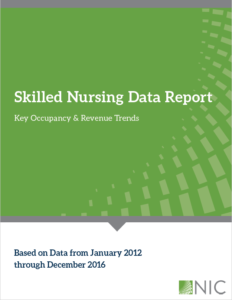NIC Skilled Nursing Data: Key Takeaways from the Fourth-Quarter 2016 Report
NIC has just released its fourth quarter 2016 Skilled Nursing Data Report, which includes key monthly data points from January 2012 through December 2016.
The current report is based on data collected monthly, but reported quarterly, from approximately 20 operators and 1,500 properties. The data represents national, aggregate figures. However, NIC plans to grow the data set, adding more operators and properties to produce state-level reports. NIC welcomes the participation of operators nationwide in this confidential data collection process. Participants will receive a free benchmark report every month for their contribution.
Here are the key takeaways from the report:
- Occupancy fell to 81.8% in 4Q 2016, a new low in the five-year data series, marking the third consecutive quarter in which occupancy reached its lowest point in the series. Occupancy was down 156 basis points year-over-year, which was the largest year-over-year decline for the fourth quarter in the data series.
- Skilled mix fell by 0.8% year-over-year to 24.3%–only slightly higher than the lowest point in the series, reached in September 2012. The rate of year-over-year change in both skilled and quality mix has been negative since 2Q 2015, with the skilled mix decline slightly greater than the quality mix decline. The skilled mix decline has been driven by pressure on Medicare mix which reached its lowest level in the data series in 4Q 2016, despite holding steady quarter-over-quarter, which was possibly due to an early and significant flu season.
- Representing 66.2% of patient days, Medicaid continued to supply a steady stream of patient days. Year over year, Medicaid patient day mix grew 126 basis points from 64.9% to 66.2%. Furthermore, Medicaid patient day mix grew 364 basis points over the length of the time-series. The 4Q 2016 data also demonstrated the continuous increase of Medicaid revenue per patient day as the rate rose to more than $200 for the first time in the five-year series. Medicaid RPPD was up 0.9% quarter-over-quarter, and 1.8% year over year, which did not keep up with wage inflation. Over the five-year series, Medicaid RPPD experienced a 1.4% compound annual growth rate.
- The decline in managed Medicare RPPD slowed by more than 50% year over year. The decrease in managed Medicare RPPD was under $9 year over year, compared to a $19 decrease between 4Q 2014 and 4Q 2015. While revenue per patient day for managed Medicare reached its lowest point in the data set at $421.84 in 4Q 2016, the 2.1% decrease over 2016 was considerably less than the prior year’s 4.3% decline. The decline quarter over quarter was also notably less than in previous quarters at 0.1%, which was the smallest decrease in the past six quarters, portending that the year-over-year decreases may continue to shrink as time progresses.
Stay tuned for a detailed article about the data in the next NIC Insider.
NIC released its latest Skilled Nursing Data Report on March 15, 2017. You can download the latest report and future reports at: http://info.nic.org/skilled_data_report_pr

